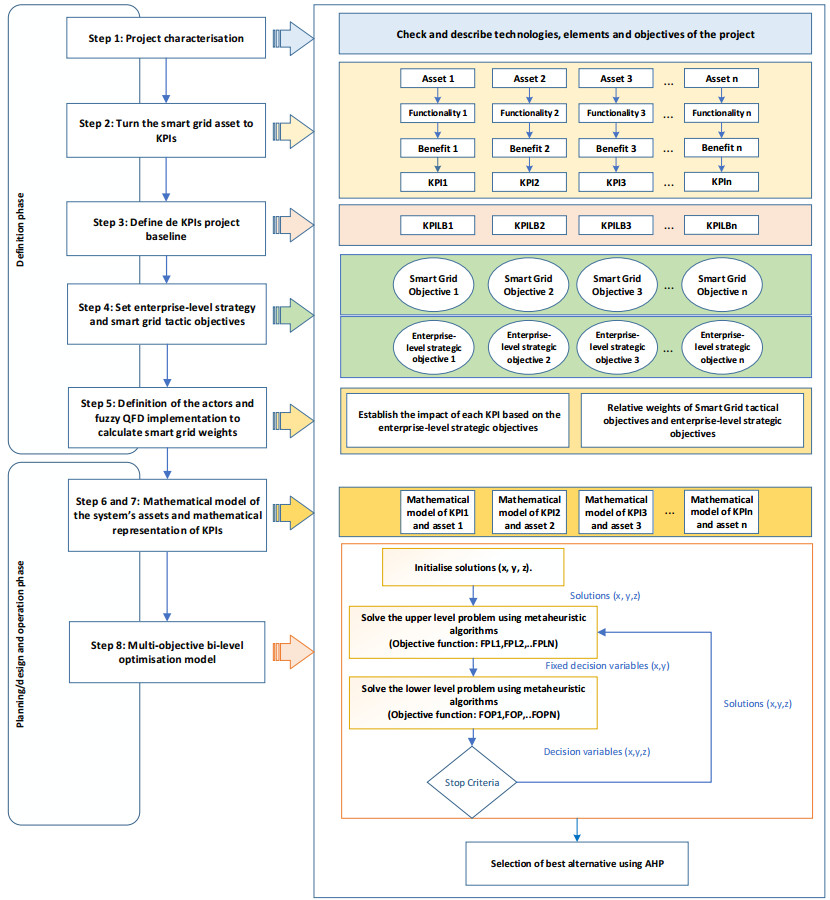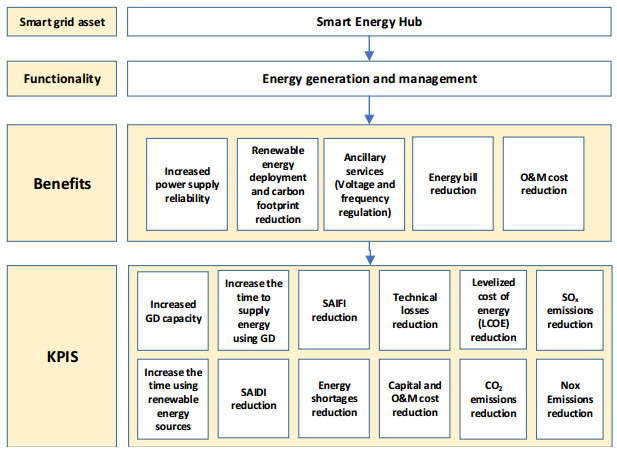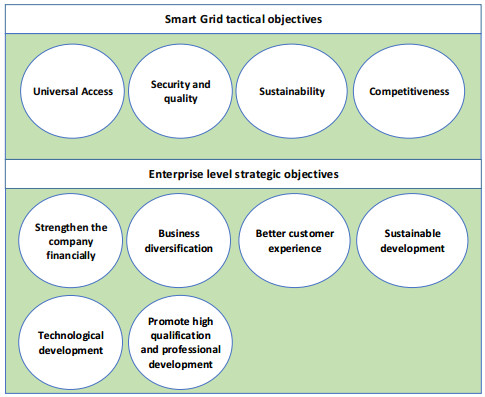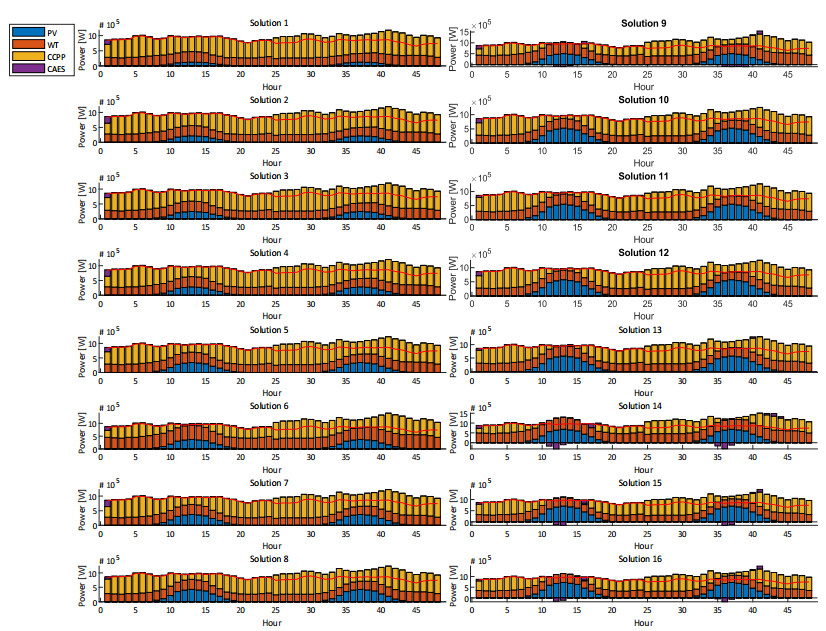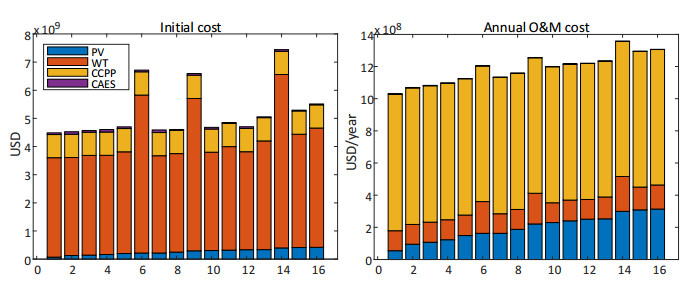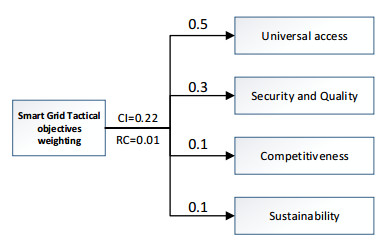1.
Introduction
During the last years, the smart grid concept has revolutionised the energy field. This concept is in charge to add non-conventional energy sources of distributed generation and a bunch of information technologies (IT) to national electric system to bring suitability, security and efficiency to energy supply [1]. Likewise, the enterprises show an opportunity to develop new services through the functionality that it represents, to build profitable business models and to provide value-added service, as their users as themselves [2].
Nevertheless, the inclusion of this concept as a new technological paradigm creates significant challenges, not least among them the technical feature [3], because of the migration of the current electrical network, which has unidirectional flows and centralised generation to disperse loads, needs to be turning to bidirectional power flows; this issue will require a sophisticated model to generate, supply, and operate energy [4] in addition to a reliable communication network for sensing, data collecting, and controlling assets. On operational level, the uncertainty associated with power generation from non-dispatchable energy sources creates the need to include storage technologies and forecasting strategies [5]. It is evident that the stability of the system depends on a continuous reading and a permanent control of the assets that assure the correct dispatch of energy and an active management of the electrical load. Although installing this type of infrastructure can be very costly [6], its benefits include increased reliability, reduced energy consumption, and consumer participation in power generation [7]. This means that planning is as important as operation in ensuring the proper functioning of the smart grid. Besides, other challenges appear to add more complexity: they not only have to evaluate the efficiency or technical effectiveness and their economic profit, but also they have to include environmental, social, and governmental political issues into a legal and strategy frame which are relevant to each region where applicable [8].
As a consequence, the complex multidimensional nature (NP-hard type) [9] in development and planning of smart grid projects could not be addressed as a unidimensional problem. Instead these require the use of optimisation techniques which consider the imbalance between stated objectives by different areas into the same energetic structure to decision-making. Worldwide authors consider that a multi-level structure could work better to build and planning smart grid projects [10], because of the possibility to coordinate and identify problems which require a commitment between the objectives of two or more interacting entities ordering by hierarchical structures with isolated objectives, maybe in dissonance. In the last decade, the use of multi-level decision-making approaches is becoming a powerful tool in the abstraction and conceptualisation of hierarchical organisation models with decentralised management problems [11]. Decision-making in several levels has promoted the researching about decision models [12], solution perspectives [13], and applications to build smart cities and smart grid projects [10].
Likewise, one of the main challenges that energetic field confront during the building a smart grid project has been the development of tools to support the decision-making process [14,15]. Into this area, operators in charge must face non-structured problems, which must bring decisions, evaluations and acknowledges based on the concern. It is necessary to use qualitative approaches that allow becoming expert human judgement to mathematical representations as analytic hierarchy process (AHP) or quality function deployment (QFD), which process uncertain or diffuse information in the smart grid field.
Finally, the use of key performance indicators (KPIs) is standing out for smart grids and smart cities projects due to they bring adequate and detailed information to actors who represent each level into organisations using multi-level approaches [16,17]. Currently, several programs and methodological proposes have tried to coordinate every one of these levels and to evaluate from different points of views, potential benefits that bring the development of smart grid projects, such as the method of multi-level maturity evaluation developed by Yue He [18], smart grid status and metrics reports designed by Energy Department of United States and the Electric Power Research Institute [19,20], and diverse evaluation cost-benefit methodologies from smart energy network projects developed in European Union [21,22,23]. All these are becoming invaluable evaluation tools with hierarchical structured KPIs.
This paper embeds all these concepts into a systematic approach called System of Systems (SoS), to make a novelty methodological tool that supports managers, planners, or political decision-makers to make optimal or near-optimal decisions about the use of smart grid assets. The provided solutions for this approach must fix all aims raised to each level in the organisation and give contributions to the energetic development in the region.
The paper is organized as follows. Section 2 defines the types of decision problems, shows a review of quantitative and qualitative decision support tools in the field of Smart Grids, shows the role of Key Performance Indicators (KPI) in energy organizations, and the concept of Systems of Systems applied to smart grids planning. Section 3 shows the proposed framework. Section 4 presents the application of the framework in a case study. Finally, Section 5 shows the conclusions.
2.
Background
The development of tools to support decision-making in smart grids projects requires solving problems of quantitative and qualitative nature at different levels of an organization. This section explains each type of this problems and shows a series of methods currently being used as solutions. Furthermore, introduces the Key performance indicators and System of Systems as an essential concept for the development of an integrated decision-making framework.
2.1. Classification of decision problems in the organisational field
Decision problems in an organisation can be classified by their degree of complexity in: structured, semi-structured and unstructured [24]. The structured ones, which are within the operating management, can be raised through the use of classical mathematical models, such as linear programming or statistical methods. At the other end of the decision management structure, there are the unstructured ones related to strategic planning; they are often vague, uncertain and imprecise, for which there is no standard solution method that allows obtaining an optimal solution [25]. Human intuition is usually the basis for decision making in an unstructured problem [26]. Typical unstructured problems are finding in business planning, job evaluation for large organisations [27,28], or in the development of a set of policies for a particular social problem [29].
Finally, semi-structured decision problems, that involve tactical management contain structured and unstructured characteristics which reflect a better approach to real situations [30]. The solution to these problems involves a combination of programming optimisation and human judgment solution procedures; also, it is necessary the support of related intelligent information processing and fuzzy inference techniques. For both these and unstructured problems, computational techniques help notably to provide information that improves the quality of the decision and therefore, its efficiency [31].
Taking into account the dynamics of decision-making and its decision structure, many of the problems that arise in an organisation require multi-level optimisation, which allow us to find the balance point of the most appropriate decisions. From this, the different actors involved in the decision-making process obtain benefits from the operational, tactical and strategic levels [17]. In the literature, it is common to find problems that involve two or three levels of decision which try to optimise their objectives under certain limitations and act and react sequentially. In these cases, they are called bi-level decision-making (BLDM) and tri-level decision-making (TLDM) [31].
2.2. Multi-level optimisation as a quantitative method in smart grid projects
In most of the literature consulted, energy management is addressing through decision techniques such as multi-objective models, multicriteria analysis, genetic algorithms, decision support systems (DSS), GIS-based decision support, and energy management system (EMS). However, these are implementing from a single level perspective. Raffaele Carli in [10] notes: ‘There is a lack of techniques that analyse existing decision levels in an integrated manner rather than level by level’; from this perspective, analysing smart grids as a single-level system is not an appropriate approach since should be considered different actors that are directly or indirectly involved in decision-making.
A multi-level optimisation problem is a type of mathematical programming that solves decentralised planning problems, with decision entities that interact and are distributing through a hierarchical organisation. The execution of decisions is sequential, from the upper level to medium level and then to the lower level. For example, in Figure 1, each decision-maker in units from 1 to K independently optimises their objectives but is affected by the actions of other decision-makers at other levels [11]. The decision units at the upper level and the lower level are called leader and follower, respectively.
According to Lu et al. [11], there are two fundamental problems in multi-level decision-making processes: the first is how to develop a model capable of describing a complex decision-making process, such as the hierarchical multi-level model; the second is how to find an optimal solution to such a process. For the first problem, decision-making models have been proposed in the literature of two [32,33] and three levels [34,35], which in some cases, include multiple objectives [36]. For the second problem, a set of solutions that solve these models has been developed, based on classical methods such as the mixed-integer linear programming (MILP) [37,38], Karush-Kuhn-Tucker (KKT) [39,40], Stackelberg [41,42], and computational algorithms such as genetic algorithms [33,43], particle swarms optimization (PSO) [33,36].
2.3. Qualitative models for decision making in smart grid projects
The multi-level optimisation technique mentioned in the previous section is useful for solving complex real-world problems, especially those that are based on quantitative data or have a tactical or operational scope. However, for strategic planning decisions, the decision-makers face unstructured problems. Therefore, they must provide judgments, assessments, and knowledge about the problem definition [44]. For this, it is necessary to deal with qualitative techniques or models that could transform the human judgments of experts into mathematical representations. Methods such as analytic hierarchy process (AHP), quality function deployment (QFD), ELECTRE, PROMETHEE, MAUT, Delphi method, and the fusion of these methods with fuzzy set theory, provide more sophisticated algorithms to process uncertain or inaccurate information in the field of the smart grids [45].
The fuzzy set theory resembles human reasoning in how it uses information and uncertainty to generate decisions. It was explicitly designed to mathematically represent uncertainty and ambiguities, and provide formal tools to deal with the intrinsic inaccuracy of many problems [46]. This work considers AHP and QFD as qualitative methods, due to the ease of capturing human judgments and that these have been implemented in the field of smart grids successfully.
The fuzzy AHP is a theory of measurement through peer comparison, which is then assembled in the expert judgment to obtain priority scales. Here, the decision-makers (experts) methodically evaluate each element to be compared with each other; these comparisons are making to determine the importance of each of them [47]. When making comparisons, experts can use concrete (quantifiable) data of the elements that are necessary or can use their judgments according to their level of relevance. The comparisons follow the numerical scale proposed by Saaty [48]. The AHP and fuzzy logic have been used successfully to support decision-making in smart grid project planning [14,49], renewable energy [50,51], microgrid projects [52], demand response programs [53], electric mobility [54], energy storage [55,56], and smart energy cities [57].
On the other hand, the QFD developed initially by Japanese professors in the 60's, Yoji Akao and Shigeru Mizuno, provides an excellent mechanism that helps identify and translate customer requirements into technical specifications for the design, process, and production of a product or services. It is also possible to use the QFD as a strategic planning tool for an intangible product, such as a program or activity. Customer requirements could interpret as corporate or commercial requirements of senior management. The team members in the QFD exercises must be mostly senior managers and all other functional level managers in the strategy formulation stage, and implementation engineers for the formulation of the action plan. Decision attributes are sometimes strategic objectives or tactical policies rather than specific objective values of product design variables. Therefore, it is more difficult to quantify and develop a mathematical model for evaluation [58]. The QFD has applied in the development of business strategies, software development, product management, vendor selection, and other applications. Eventually, the QFD has also implemented in the energy sector and smart grid projects [59,60]. In [61] and [62] are detailed the models, methods, concepts, and applications of both techniques.
2.4. Key performance indicators and their use in Smart Grid projects
A key performance indicator is a tool widely used worldwide in industries and business environments to quantify and evaluate progress and performance concerning the goals and objectives of an organization [63]. To increase awareness of the status of energy sector projects and facilitate their monitoring, the actors in charge have some of these indicators to monitor in a comfortable and detailed way the fulfilment of the objectives.
The sector has formulated some KPIs and their applicability in smart grid projects [64,65], microgrids [66,67], monitoring and planning architectures [68,69], energy efficiency and demand response [16,70], energy management systems (EMS) [71,72] and smart cities [10,73]. However, the methods are predominantly qualitative, as the selection of KPIs comes from a review of the literature, validation with stakeholders, or discussion with energy industry actors and experts [17]. The difficulty is due to the constant evolution of ‘Smart or Smartness’ term and the lack of clarity of the concept [74]. It also emphasises the absence of an indicator system that is capable of providing a uniform approach to what is measured, and of being comparable over time, or between different regions [18].
Another critical challenge that KPIs represent in the field of smart grids is in the allocation of weights and their impact on strategic energy objectives. To obtain these weights, some authors like [16] use interviews and consensus with project experts as an evaluation tool (direct assignment methods). In [65,66] introduced a methodology for the evaluation of microgrids and smart grid technologies, determining each evaluation core with an equal magnitude of importance. Although, in [75] and [76] they consider more rigorous mathematical processes for the determination of weights, in the first investigation it is not necessary to obtain the results of quantifiable KPIs, and unlike what was done by [16], they did not consider the participation of experts for qualitative evaluation. The second investigation presents a binary evaluation approach; therefore, those projects that have an intelligent criterion mildly or intensely will obtain the same score. The six categories, where the indicators are examining, were assigned with the same weight to calculate the overall score, giving them the same importance to each. In [64], the authors use a multicriteria AHP technique to determine the relative weights of indicators proposed in the field of smart grid projects in China. The work carried out by Kazumi in [46], considers the QFD with fuzzy logic. The work shows an example through a simulation to achieve the prioritisation of energy indicators as inputs for software development in energy management in a company.
Due to the above, it is favourable to establish a quantitative and systematic method that allows weighting and validating KPIs based on the identification of the functionalities of the smart grid asset. For this, this work considers what has been done by the Department of Energy (DOE) in [77]. Regarding the prioritisation of KPIs based on the strategic objectives of the company, section 3 presents a new procedure for assigning significant weights using the QFD-AHP with fuzzy logic.
2.5. The System of Systems concept as the basis for multi-level decision making in Smart Grid project planning
Finally, the SoS concept would allow joining the concepts mentioned above and adequately guide the strategic investments made in the modernisation of the conventional electricity grid [78,79]. Also, it serves as the basis for developing requirements and standards, making design decisions, acquiring solutions and managing any type of smart grid or smart energy city project [80,81]. Each of these projects could consider being typically composed of hardware, software, processes, procedures, policies and actors; what makes the project designer, or in this case of the system, have to analyse each of these factors holistically [10].
For this, the systems development life cycle (SDLC) is a conceptual model that allows obtaining an overview and describe the stages and tasks involved in each phase of a system. The SDLC allows a process to be broken down into smaller segments or phases for ease of management and for managers to verify successful completion of initial project phases before allocating resources to subsequent phases [82]. In general, systems development includes requirements analysis, design/planning, testing, implementation and operation phases. However, these can be divided differently depending on the organisation involved. The SDLC is similar to the life cycle of any smart grid project. In fact, in many cases, the SDLC allows defining the policies, personnel, and budgetary limitations of a large-scale project implemented in an organisation [83]. This model also allows to capture the needs and objectives of the actors and transform them into a holistic solution through a balanced life cycle that meets the minimum design requirements and maximises the overall efficiency of the system [84]. Figure 2 presents a general model of the SDLC and the methodological proposal developed in this work for the evaluation of smart grid projects. The actions in the phase of defining the technical process, design and, operation and maintenance (O & M) present the innovation of this work, which are explaining in more detail in the following section.
3.
Methodological approach
Based on the methodology proposed in [81], where is pointed that any smart grid project can consider as an SoS, here we present an innovated methodology divided into three phases of SDLC: technical processing definition, planning/design, and operation. The first phase uses fuzzy QFD as qualitative methods to help in the decision-making procedure; it also includes actors and objectives as tactical as strategy levels. The other phases are addressing as a multi-objective bi-level optimisation problem, i.e., they represent the quantifiable method.
Here, the leader or upper-level problem is represented as the planning/design phase while the operation phase is the follower or the lower level problem. Similar to traditional energetic sector problems, planning/design is a long-term procedure while the operation is a short one. Although they look different, these are strictly related, and therefore, a bi-level decision-making model can interact to get optimal modelling [85]. The upper level gets input information from the planning horizon (i.e., technical processing definition), the maximum load, the available assets, and the economic parameters. When it chooses a matching design, i.e., the number of assets for the smart grid project, under input information and constraints, then the second level is enabled. Thus, data from the upper-level are using as parameters in the lower-level with a function which defines the problem's feasible region. Then, the lower-level defines the operational solutions for assets such that loss functions as the emissions, the operational costs, the SAIDI, and other requirements achieve a minimal cost. Once the solutions are getting from lower-level, these go back to upper-level to evaluate the total cost during the planning horizon. This procedure continues until achieving both the design and the optimal operative combination. After a set of solutions are obtained by the optimisation model, the enterprise stakeholders use fuzzy AHP in order to select the best fitted solution. Each of these steps is explaining below.
3.1. Technical processing definition phase
This is a five-steps phase where the information and data of the projected is obtained and used to define specific KPIs and objectives.
3.1.1. Step 1. Smart grid project characterisation
Following the work presented in [86], the technical processing definition phase takes the project general summary, the available technologies, elements, and objectives, which imply to bring the project scale and dimension, i.e., user support for the smart grid, energy consumption per year, load profile, generation data from solar, wind, or others.
3.1.2. Step 2. Turn the smart grid asset to KPIs
This step comes from [77]. The implementation takes the smart grid investment characterisation using turnings from 1) smart grid assets based on functionalities, 2) functionalities turn on benefits, 3) benefits to KPIs, and 4) obtaining the mathematical representation of each KPI.
3.1.3. Step 3. Define the KPI project baseline
By using the methodology presented in [86], the step aims to compare new scenarios against the current one to know the cost and benefit differences. This work includes the next scenarios:
- Scenario A (Baseline): This scenario shows the system conditions before implementing the smart grid project.
- Scenario B: Setting conditions and polities in the proposed smart grid system.
3.1.4. Step 4. Set enterprise-level strategy and smart grid tactic objectives
Here, the strategic objectives are set based on the needs and goals from each energetic enterprise which implements a smart grid project. This step also includes the smart grid tactic objectives such as was presented in [87]; these are strictly relating with issues as climatic change, traditional energy scarcity, and problems in security, quality and supply.
3.1.5. Step 5. Definition of actors and Fuzzy QFD implementation to calculate the smart grid weights
Fuzzy QFD is applied to find the relationship between KPIs and the energetic enterprise-level strategic objectives.
From Table 1, we get the enterprise-level strategic objectives prioritisation (HOW). While Table 2 define WHAT is the importance to satisfy a KPI to achieve an enterprise objective.
The results from Tables 1 and 2 come from [88] and [89], where were added some modifications and fuzzy logic to get the linguistic enhancement and the prioritisation of smart grid objectives. However, it is necessary to define some expert actors into the smart grid field and the energy companies; some of them come from [17], where was detailed the participation during the life cycle of smart grid project.
3.2. Planning/design and operation phases
This is a three-steps phase where the information of the project and the selected KPIs are integrated into an optimization model in order to obtain the best solution.
3.2.1. Step 6. Mathematical model of the system's assets
This step must represent the operative constraints from project formulation in a precise way; therefore, each proposed asset from step 2 must model adequately.
3.2.2. Step 7. Mathematical representation of KPIs
From step 2, it is necessary to develop the mathematical representation of each KPI. Each one has operative and planning constraints which help to obtain optimal solution during the optimisation procedure.
3.2.3. Step 8. Multi-objective bi-level optimization model
To optimise the planning/design and operation phases in a coordinated fashion, we introduce the multi-objective bi-level optimisation model which is composed of the leader located in the upper-level (planning/design) and the follower located in the lower-level (operation). (1) presents its mathematical representation.
where, xPL,yPL,…,zN are the arguments to be optimised, and FPL1,FPL2,…,FPLNare the objective functions, and G(⋅)yH(⋅) are the set of planning constraints located in the upper-level. The lower-level has zN,t which are the decision arguments, where t is the operation time, fop1,fop2,…,fopnare the loss function, and g(⋅)yh(⋅)are the operative constraints.
The multi-level optimisation is currently a high-interest topic into the science of administration, economics, and engineering. Here, the bi-level model preserves the relationship between both levels. While the planning/design phase has its objectives into a decision profile, indirectly defined by the operational level, it helps to turn the conditions for a new optimisation procedure into the lower-level when the control is delivered. This model allows interacting between the objectives in both levels, as the decision-makers find a logic relationship into an energy project.
However, this kind of problems considered as NP-hard due to intrinsic complexity between two levels are hard to solve; even, the simplest case, being continuous and linear functions, is still considered as NP-hard [90]. Thus, the use of meta-heuristic algorithms is necessary to solve this kind of problems [91]. The solution obtained by the optimization model is not unique. Thus, it is necessary to apply a method in order to find the best solution weighting the Smart Grid objectives. The relative weights are calculated based on energetic regional polities using AHP approach (See Table 3). In [92] are explained the axioms, theorems, and mathematical foundations to establish the priorities obtained with the fuzzy AHP.
4.
Results
In the following, we present a step-by-step example procedure to apply the proposed methodology.
Step 1. The Mexican government aims to structure sustainable energy projects to reduce the use of fossil fuels in the Yucatan Peninsula. They want to observe through the simulations the feasibility of building an isolated smart energy hub (SEH) to provide the energy service of the population present there. For the case study, the planning horizon is 30 years and operating 48 hours. The SEH considers the following four assets: combined cycle generating (400 MW), solar farms (295 W per panel), wind farms (2 MW turbine), and Advanced Adiabatic Compressed Air Energy Storage system AA-CAES (210 MW).
Step 2. Figure 3 presents the functionalities of the assets transformed into benefits and these into a measurement parameter KPI, where are identifying two functionalities, five benefits, and twelve KPIs.
Step 3. Table 4 presents a comparison between the current scenario (scenario A) and the scenario with the smart grid project (Scenario B).
Step 4. Figure 4 shows the six strategic objectives defined by the energy company executing the project and the smart grid objectives established in the Mexican energy framework.
Step 5. Tables 5 and 6 show the evaluations given by the actors of the energy company for the assessment of objectives and KPIs using the Fuzzy-QFD tool.
Table 7 shows the valuations given with their respective fuzzy number, where the labels are: VL = Very Low, L = Low, M = Medium, H = High, and VH = Very High.
After mathematically processing the assessments given by the project actors the essential KPIs are as follows: First KPI3, second KPI2 and third KPI9.
Step 6. As a brief example, two of four assets considered in this study are presented in (2) for a photovoltaic subsystem model and in (3) for a wind turbine subsystem model. However, energy storage technologies, such as batteries and compressed air energy storage, and non-renewable energy sources must be considered in the methodology.
Step 7. Similarly to step 6, (4) and (5) presents two mathematical models of twelve KPIs considered in the study. KPI4 is represented by the System Average Interruption Duration Index (SAIDI) while KPI9 is represented by the Levelized Cost of Energy (LCOE).
Step 8. In this paper, we used a Bi-Level Multi-Objective Particle Swarm Optimization algorithm (BLMOPSO).
Table 8 shows 16 reasonable solutions at the planning/design level for the case study; Figure 5 shows the solutions given by the algorithm at the operation level. In the proposed scenario, there is a low generation with renewable energy sources on the second day of operation as a result of not too windy and not too sunny. The algorithm compensates this deficit with combined cycle generation plants; in some cases, as solution three at 1:00 AM, the combined cycle generation supplies 685 MW; In the first 24 hours of operation of all 16 solutions, a high penetration of renewable sources is observed, in some cases, as solutions nine, fourteen, fifteen and sixteen, these required the use of AA-CAES.
Table 9 presents the optimised KPI and baseline KPI values for the case study. Figure 6 shows, the percentage difference of KPI9 (minimise LCOE). Notice that all solutions are more expensive than the baseline; solution 14 with an LCOE of $ 0.27/kWh is considered the most expensive with the 33% above on the baseline.
Figure 7 shows the initial investment and operation and maintenance costs for the case study.
Next, the prioritisation of the smart grid tactical objectives obtained from the fuzzy AHP tool is presenting in Figure 8. The evaluation to get the prioritisation consisted of 67 actors in the energy sector and experts in the field.
As it can be seen in Figure 8, the FAU (Universal Energy Access) objective was the most important with 50%, followed by fsc (Security and Quality of energy supply) with 30%, and finally FComp (competitiveness for the company) and fs (environmental sustainability) with 10% each one, respectively. After weighting both KPIs and objectives, it is possible to determine a feasible solution. For the case study, the solutions one, two, and three are potential candidates due to they present the lowest cost and the least tons of carbon dioxide t CO2, sulfur oxides kg SOx and nitrogen oxides kg NOx. However, the obtained relative weights with the use of the AHP mean that the solution tends to be more linked to Universal Access, which was the essential objective with a 50% relative weight of importance. Therefore, by introducing these weights in the algorithm, solution nine is the best solution for the case study.
5.
Conclusions
This paper presents a methodological proposal that provides support for decision-making in energy companies that wish to build smart grid projects. The main challenge of this research was the abstraction of the organisational hierarchy and turned it into a multi-level decision process architecture. For this, it was necessary to have a systemic approach which allowed, first to identify and describe the elements of the project, the key actors and their interests, the objectives, and relationships for each decision level. In the other two subsequent phases, planning/design and operation, we implemented an innovative multi-level multi-objective decision model to get a set of solutions using PSO. This procedure was applied in the Yucatan Peninsula in Mexico to validate the proposed methodology.
As a contribution, this work helps to gradually fill the gap in the literature regarding those techniques that analyse decision levels in an embedded way instead of level by level, being particularly important in the current era of smart cities and smart grid projects, due to they are considered as a complex network of systems, and therefore require analysis in a holistic way and not separately. Additionally, the methodology allows the use of KPIs to measure the performance of any project, being important since in the not too distant future they will have to develop action plans to improve the objectives in terms of energy efficiency and environmental sustainability, such as they are starting to demand in most governments around the world.
Since the methodology involves the asset and its functionality as a crucial part, this framework can be applied on any smart grid project despite its size, architecture or use of technologies. This includes on-grid and islanded configurations, AC or DC architectures, and centralized or decentralized topologies. However, to take full advantage of the framework it is important to define KPIs, tactical objectives and strategic objectives that highlight the benefits of each configuration or topology.
Currently, the methodology is within the problems of optimisation of two levels and with multiple objectives. As future work, the integration of several subsystems would be crucial to turn the problem into a multi-follower or multi-leader into a cooperative, semi-cooperative or non-cooperative nature. Thus, the planning and operation of several smart grid projects might carry out simultaneously.
Conflict of interest
All authors declare no conflict of interest in this paper.
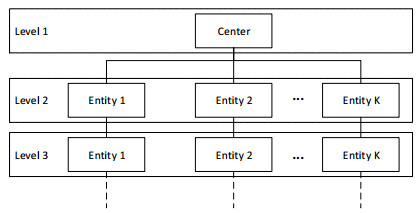









 DownLoad:
DownLoad:
